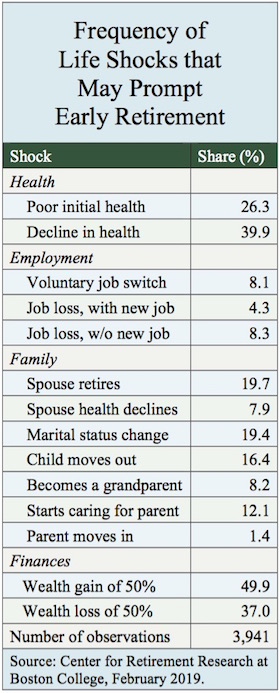Brighthouse Financial, Inc., reported this week that annuity sales increased 27% quarter-over-quarter and 10% sequentially in the fourth quarter of 2018, the highest since Brighthouse split off from MetLife. Higher sales of the Shield structured indexed annuity and fixed indexed annuities drove the increase, a release said.
Overall, Brighthouse reported net income available to shareholders of $1,442 million in the fourth quarter of 2018, or $12.14 on a per diluted share basis, compared to net income available to shareholders of $668 million in the fourth quarter of 2017.
The company ended the fourth quarter of 2018 with stockholders’ equity (“book value”) of $14.4 billion, or $122.67 on a per share basis, and book value, excluding accumulated other comprehensive income (“AOCI”) of $13.7 billion, or $116.58 on a per share basis.
For the fourth quarter of 2018, the company reported adjusted earnings* of $186 million, or $1.56 on a per diluted share basis.
The adjusted earnings for the quarter reflected $13 million of net unfavorable notable items, or $0.11 on a per diluted share basis, including a $26 million net favorable impact related to modeling improvements resulting from an actuarial system conversion and establishment costs of $39 million related to planned technology and branding expenses associated with the company’s separation from its former parent company.
For the full year 2018, the company reported net income available to shareholders of $865 million, or $7.21 on a per diluted share basis. The company reported full year adjusted earnings of $892 million, or $7.44 on a per diluted share basis, and full year adjusted earnings, less notable items, of $998 million, or $8.33 on a per diluted share basis.
Corporate expenses in the fourth quarter of 2018 were $233 million pre-tax, down from $242 million pre-tax in the third quarter of 2018. During the quarter, the company repurchased $63 million of its common stock under its stock repurchase program announced on August 6, 2018, resulting in a total of $105 million of its shares repurchased during 2018.
American Equity Investment Life
The holding company for American Equity Investment Life reported this week that total sales by independent agents for American Equity Investment Life Insurance Company (American Equity Life) increased 13% in the fourth quarter of 2018, relative to the previous quarter, while total sales by broker-dealers and banks for Eagle Life Insurance Company (Eagle Life) decreased by $23 million or 12% relative to the previous quarter.
Sales of FIAs were up 11% from the previous quarter, to $1.1 billion. They were driven by a 14% increase in sales for American Equity Life. FIA sales for Eagle Life, at $163 million, were down $1 million or about one percent from the previous quarter, the company said in a release.
“We experienced sequential and year-over-year increases in FIA sales in American Equity Life’s independent agent channel,” said John Matovina, chairman and CEO, in a statement. “Our higher new money investment yields allowed us to take several actions late in the third quarter and early in the fourth quarter to enhance our competitiveness in both the accumulation and guaranteed lifetime income market segments.
“The launch of AssetShield on October 9 was successful; it joins IncomeShield as one of our two top selling products. In the fourth quarter, combined sales for AssetShield and the Choice series, our other accumulation product in the independent agent channel, were greater than total sales of Choice in the third quarter. Choice and AssetShield accounted for 38% of sales in the fourth quarter compared to 35% of sales in the third quarter.
“In the guaranteed lifetime income space, we improved the competitive position of the IncomeShield series and our other guaranteed income products by increasing payout factors in early October. The IncomeShield series, which was the third best-selling guaranteed lifetime income product in the independent agent channel in the third quarter, accounted for 33% of our FIA sales in the fourth quarter.”
Commenting on the market environment and the outlook for FIA sales, Matovina added: “The market in each of our distribution channels continues to be challenging. However, we are pleased with our competitive positioning for both accumulation and guaranteed lifetime income products. Business activity in January 2019 was appreciably ahead of January 2018 and we are optimistic that the sales momentum we developed in the fourth quarter will continue in 2019.”
“In the bank channel, we are seeing meaningful sales from the large bank we referenced in our prior release and continue to expect this relationship to be a key account for Eagle Life. We are also continuing to build out our employee wholesaling model which will be a key initiative for Eagle Life in 2019,” Matovina said.
“Our intent is to use our employee wholesalers to target accounts that do not use third party wholesalers and to complement our third party wholesalers when possible. When accomplished, we will be able to serve banks and broker-dealers in the manner in which they desire while lowering our distribution costs.”
Policyholder funds under management at December 31, 2018 were $51.1 billion, a $441 million or 1% increase from September 30, 2018. Fourth quarter sales were $1.1 billion before coinsurance ceded and $1.0 billion after coinsurance ceded. Gross sales and net sales for the quarter increased 12% and 18%, respectively, from fourth quarter 2017 sales. On a sequential basis, gross and net sales increased 8% and 12%, respectively.
American Equity’s investment spread was 2.56% for the fourth quarter of 2018 compared to 2.67% for the third quarter of 2018 and 2.75% for the fourth quarter of 2017. On a sequential basis, the average yield on invested assets decreased by 3 basis points while the cost of money rose 8 basis points.
Average yield on invested assets was 4.51% in the fourth quarter of 2018 compared to 4.54% in the third quarter of 2018. This decrease was primarily attributable to a decline in the benefit from non-trendable investment income items from 11 basis points in the third quarter to 7 basis points in the fourth quarter. The average yield on fixed income securities purchased and commercial mortgage loans funded in the fourth quarter of 2018 was 5.02% compared to 4.97% in the third quarter of 2018 and 4.61% for the first six months of 2018.
The aggregate cost of money for annuity liabilities of 1.95% in the fourth quarter of 2018 was up 8 basis points from 1.87% in the third quarter of 2018. The benefit from over hedging index linked interest obligations was 3 basis points in the fourth quarter of 2018 compared to 7 basis points in the third quarter of 2018.
American Equity reported fourth quarter 2018 net income of $53.8 million, or $0.59 per diluted common share, compared to net income of $36.8 million, or $0.41 per diluted common share, for fourth quarter 2017.
For the year ended December 31, 2018, net income was $458.0 million, or $5.01 per diluted common share, compared to $174.6 million, or $1.93 per diluted common share, for the year ended December 31, 2017.
Non-GAAP operating income1 for the fourth quarter of 2018 was $90.3 million, or $0.99 per diluted common share, compared to non-GAAP operating income1 of $74.5 million, or $0.82 per diluted common share, for fourth quarter 2017. For the year ended December 31, 2018, non-GAAP operating income1 was $425.7 million, or $4.66 per diluted common share, compared to $285.1 million, or $3.16 per diluted common share, for the year ended December 31, 2017. Non-GAAP operating return on average equity excluding average AOCI1 for the year was 18.6% based upon reported results and 15.4% excluding the impact of assumption revisions.
Prudential Financial
Prudential Financial, Inc. this week reported year-end and fourth quarter 2018 results. Net income was $4.074 billion ($9.50 per common share) for the year ended December 31, 2018, compared to $7.863 billion ($17.86 per common share) for previous year.
After-tax adjusted operating income was $5.019 billion ($11.69 per Common share) for 2018, up from $4.652 billion ($10.58 per Common share) for 2017.
U.S. Individual Solutions, consisting of the Individual Annuities and Individual Life segments, reported adjusted operating income of $419 million for the fourth quarter of 2018, down from $639 million in the year-ago quarter.
The Individual Annuities segment reported adjusted operating income of $445 million in the current quarter, compared to $541 million in the year-ago quarter. Excluding the notable items above, results decreased $38 million from the year-ago quarter reflecting lower policy fees, net of associated risk management and other related costs, driven by a decrease in average variable annuity account values. These decreases were partially offset by favorable hedging results and a greater contribution from net investment spread results.
Individual Annuities account values were $151 billion as of December 31, 2018, down 10% from a year earlier, driven by market depreciation and net outflows over the year. Individual Annuities gross sales were $2.2 billion in the current quarter, up 38% from the year-ago quarter, reflecting favorable customer reaction to pricing actions and sales of our fixed index annuity product, which launched in the first quarter of 2018.
For the fourth quarter of 2018, net income attributable to Prudential Financial, Inc., was $842 million ($1.99 per Common share), compared to $3.765 billion ($8.61 per Common share) for the fourth quarter of 2017. After-tax adjusted operating income was $1.035 billion ($2.44 per Common share) for the fourth quarter of 2018, compared to $1.173 billion ($2.69 per Common share) for the fourth quarter of 2017.
Consolidated adjusted operating income, adjusted book value and adjusted operating return on equity are non-GAAP measures. These measures are discussed later in this press release under “Forward-Looking Statements and Non-GAAP Measures” and reconciliations to the most comparable GAAP measures are provided in the tables that accompany this release.
The Company’s ongoing operations include PGIM, U.S. Workplace Solutions, U.S. Individual Solutions, International Insurance, and Corporate & Other Operations. In the following segment-level discussion, adjusted operating income refers to pre-tax results.
PGIM, the Company’s global investment management businesses, reported adjusted operating income of $243 million for the current quarter, compared to $306 million in the year-ago quarter.
The decrease of $63 million from the year-ago quarter reflects a $67 million lower contribution from other related revenues, net of associated expenses, which amounted to $57 million for the current quarter. This decrease was partially offset by higher asset management fees, reflecting an increase in average assets under management.
PGIM assets under management of $1.161 trillion were $6 billion higher than the year-ago quarter driven by fixed income inflows partially offset by equity outflows and market depreciation. Unaffiliated third-party net outflows in the current quarter of $3.1 billion included a single institutional fixed income client outflow of $9 billion. Total PGIM net inflows in the current quarter were $9 billion.
U.S. Workplace Solutions, consisting of the Retirement and Group Insurance segments, reported adjusted operating income of $249 million for the fourth quarter of 2018, compared to $313 million in the year-ago quarter.
The Retirement segment reported adjusted operating income of $216 million for the current quarter, compared to $291 million in the year-ago quarter. Excluding the notable items above, results increased $25 million from the year-ago quarter reflecting a higher contribution from net investment spread results and an increase in underwriting gains from growth within our pension risk transfer business.
Retirement account values were $432 billion as of December 31, 2018, up 1% from a year earlier, reflecting positive net flows partially offset by market depreciation. Net flows in the current quarter of $6.2 billion included several pension risk transfer sales totaling $7.5 billion.
Lincoln Financial Group
Lincoln Financial Group this week reported net income for the fourth quarter of 2018 of $399 million, or $1.80 per diluted share available to common stockholders, compared to net income in the fourth quarter of 2017 of $816 million, or $3.67 per diluted share available to common stockholders.
Fourth quarter adjusted income from operations was $475 million, or $2.15 per diluted share available to common stockholders, compared to $440 million, or $1.98 per diluted share available to common stockholders, in the fourth quarter of 2017.
The Annuities segment reported income from operations of $258 million in 4Q2018 compared to $265 million in the prior-year quarter, as a lower reported tax rate as a result of tax reform was more than offset by a decrease in average account values driven primarily by the Athene reinsurance transaction completed in the fourth quarter.
Total annuity deposits of $3.8 billion were up 35% from the prior-year quarter as both variable and fixed annuities benefitted from product and distribution expansion. Variable annuity sales were up 15% versus the prior-year quarter and fixed annuity sales increased 102% over the same period.
Net flows were $675 million in the quarter, which included positive flows from both variable and fixed annuities, compared to net outflows of $222 million in the prior-year period.
For the full year, total annuity sales of $12.4 billion increased 42% versus the prior year. Net outflows of $139 million for the year improved from $2.7 billion in 2017. As a result of the reinsurance transaction in the fourth quarter, average account values decreased 8% from the prior-year period but increased 2% for the full year.
Retirement Plan Services reported income from operations of $45 million, up 10% compared to the prior-year quarter. The growth in earnings is attributable to a lower reported tax rate as a result of tax reform and lower expenses.
Total deposits for the quarter of $2.2 billion were down 11% while deposits for the full year increased 18% to $10.1 billion driven by a 32% increase in first-year sales and 8% growth in recurring deposits.
Net flows totaled $173 million in the quarter compared to $440 million in the prior-year period. For the full year, net flows totaled $2.5 billion, up 76% compared to the prior year. Average account values of $70 billion were up 5% from the prior-year quarter primarily driven by positive net flows.
Net income for the full year of 2018 was $1.6 billion, or $7.40 per diluted share available to common stockholders, compared to $2.1 billion, or $9.22 per diluted share available to common stockholders in 2017. Full year 2018 adjusted income from operations was $1.9 billion, or $8.48 per diluted share available to common stockholders, compared to $1.8 billion, or $7.79 per diluted share, available to common stockholders, for the full year of 2017.
Net income in the prior-year quarter and full year 2017 included non-recurring net favorable items of $417 million primarily related to tax reform.
“Fourth quarter adjusted operating EPS growth of 9% and ROE of 13.5% were strong and consistent with our record full-year results,” said Dennis R. Glass, president and CEO of Lincoln Financial Group.
“Significant accomplishments this past year include restoring positive flows in the Annuities business, outperforming our expectations for the Liberty acquisition, and executing on strategic transactions, which resulted in $2.5 billion of capital deployment. Given our positive momentum, we remain well positioned to drive long-term shareholder value.”
© 2019 RIJ Publishing LLC. All rights reserved.

















